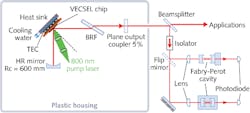Narrow-Linewidth Lasers: Single-frequency VECSEL puts out 23 W
Spectroscopy, laser metrology, optical free-space telecommunications, and laser cooling are all applications that require or benefit from single-frequency (single-longitudinal-mode) lasers. High-power vertical-external-cavity surface-emitting lasers (VECSELs) can be made to have narrow linewidths, along with tunability. Their design is also very flexible, allowing many types of intracavity optical elements to be inserted for various uses.
While multimode VECSELs have been created that emit up to 106 W, some applications (metrology, for example) often require a single-frequency high-power light source with a single-transverse-mode output. Researchers at Philipps-Universität Marburg and NAsP III/V GmbH (both in Marburg, Germany) have filled this need by developing a single-frequency, single-transverse-mode VECSEL that has a continuous-wave (CW) output of 23.6 W at 1013 nm.1
The laser has a free-running linewidth of only 407 kHz when measured over a 1 ms sampling time and a less than 100 kHz linewidth when measured over a time of 100 μs.
V-shaped cavity
The VECSEL chip itself has 10 indium gallium arsenide (InGaAs) quantum wells (QWs) separated by gallium arsenide phosphide (GaAsP) barriers. The chip is pumped with 120 W of 808 nm light from a fiber-coupled laser. The VECSEL cavity defining its lasing path consists of two mirrors placed at a 45° incidence angle, producing a 140 mm cavity length. Behind the VECSEL chip itself is a thermoelectric cooler, which itself is watercooled to a heat-sink temperature of 16°C (see figure).
The V-shaped cavity is the key difference between this laser setup and previous VECSEL cavity configurations, in which the chip served also as a cavity end mirror: the intracavity laser light now traverses the chip’s gain region twice as often per cavity round trip, and the gain is also doubled. A birefringent filter (BRF) placed inside the cavity helps to maintain single-frequency operation.
In addition to vibration isolation, the laser setup is contained within walls of 20-mm-thick plastic, and rests on acoustic foam; these measures help reduce thermal and acoustic noise.
Laser threshold was determined to be 15 W, with a slope efficiency of 44%. If the 30% reflection loss of pump light at the air-chip interface is neglected, the laser has a 33% optical-to-optical efficiency at its 23.6 W maximum output (71.2 W pump input).
At a 20 W output power, the researchers observed single-frequency operation for periods of a minute or more without mode-hopping. Increasing the pump power to more than 70 W changed the output to multiple-longitudinal mode. The laser maintained a high-quality single-transverse-mode output at all times.
REFERENCE
1. Fan Zhang et al., Opt. Express, 22, p. 12817 (June 2014).

John Wallace | Senior Technical Editor (1998-2022)
John Wallace was with Laser Focus World for nearly 25 years, retiring in late June 2022. He obtained a bachelor's degree in mechanical engineering and physics at Rutgers University and a master's in optical engineering at the University of Rochester. Before becoming an editor, John worked as an engineer at RCA, Exxon, Eastman Kodak, and GCA Corporation.
